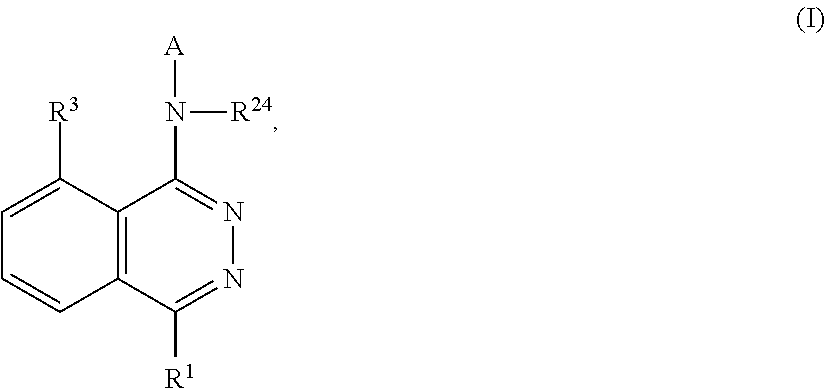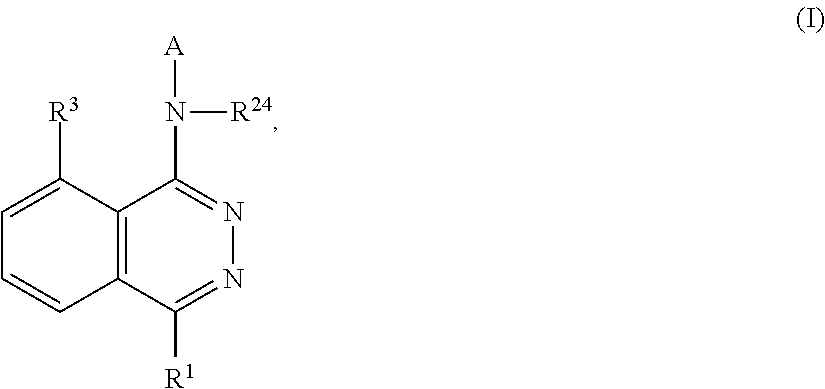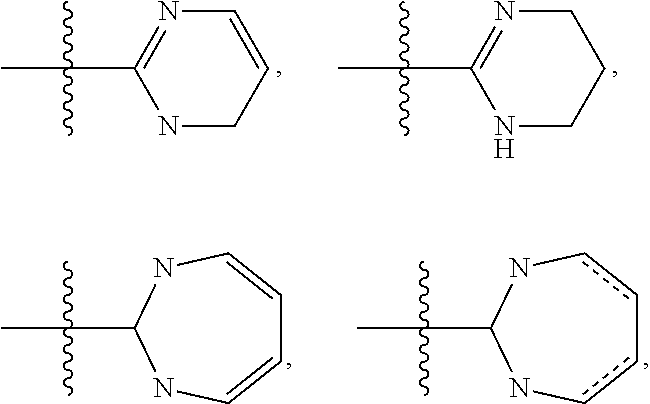Phthalazines as potassium ion channel inhibitors
a potassium ion channel and inhibitor technology, applied in the field of phthalazines as potassium ion channel inhibitors, can solve the problems of neurotoxicity, gastrointestinal discomfort, nephrotoxicity,
- Summary
- Abstract
- Description
- Claims
- Application Information
AI Technical Summary
Benefits of technology
Problems solved by technology
Method used
Image
Examples
example 1
5-(5-Phenyl-4-(pyridin-2-ylmethylamino)phthalazin-1-yl)pyridine-3-sulfonamide
[0598]
[0599]A solution of dimethyl 3-iodophthalate (WO 2008 / 115516) (1.00 g, 3.12 mmol), phenylboronic acid (0.571 g, 4.69 mmol), K2CO3 (0.880 g, 9.30 mmol) in 1,4-dioxane (15 mL) and water (4 mL) was purged with nitrogen for 30 min. Pd(dppf)Cl2:DCM (0.219 g, 0.312 mmol) was added and the reaction mixture was heated at 100° C. for 12 h. The reaction mixture was filtered through a pad of CELITE® and the pad was washed with water (50 mL). The filtrate was extracted with EtOAc (2×100 mL). The combined organic extracts were dried over anhydrous Na2SO4, filtered and concentrated under reduced pressure. The resulting residue was purified by combiflash (REDISEP®, silica gel, 12 g, 20% EtOAc / hexanes) to obtain dimethyl [1,1′-biphenyl]-2,3-dicarboxylate (0.65 g, 77.0%) as an off-white solid. LCMS (Condition 11): retention time 0.96 min, [M-MeOH+1]=239.3. 1H NMR (400 MHz, DMSO-d6) δ 3.59 (s, 3 H), 3.85 (s, 3 H), 7.33...
example 2
N-(5-(4-(Benzylamino)-5-phenylphthalazin-1-yl)pyridin-3-yl)acetamide
[0610]
[0611]5-(4-Chloro-5-phenylphthalazin-1-yl)pyridin-3-amine (0.800 g, 66.1% yield) was prepared from 1,4-dichloro-5-phenylphthalazine (1.00 g, 3.63 mmol), 5-(4,4,5,5-tetramethyl-1,3,2-dioxaborolan-2-yl)pyridin-3-amine (0.960 g, 4.36 mmol, commercial), K3PO4 (0.772 g, 3.63 mmol), Pd2(dba)3 (0.0330 g, 0.0360 mmol) and tricyclohexylphosphine (0.0200 g, 0.0730 mmol) by the methods described for the preparation of N-(tert-butyl)-5-(4-chloro-5-phenylphthalazin-1-yl)pyridine-3-sulfonamide in Example 1. The crude residue was taken to the next step without further purification. LCMS (Condition 11): retention time 0.86 min, [M+1]=333.1.
[0612]
[0613]4-(5-Aminopyridin-3-yl)-N-benzyl-8-phenylphthalazin-1-amine (0.300 g, 30.9% yield, white solid) was prepared from 5-(4-chloro-5-phenylphthalazin-1-yl)pyridin-3-amine (0.800 g, 2.40 mmol) and benzylamine (10.0 mL, 92.0 mmol) by the methods described for the preparation of N-(tert...
example 3
N-(5-(4-(Benzylamino)-5-phenylphthalazin-1-yl)pyridin-3-yl)methanesulfonamide
[0616]
[0617]To a solution of 4-(5-aminopyridin-3-yl)-N-benzyl-8-phenylphthalazin-1-amine (60.0 mg, 0.149 mmol) in DCM (20 mL) was added pyridine (0.0241 mL, 0.297 mmol) at room temperature followed by methanesulfonyl chloride (0.0120 mL, 0.149 mmol) and the reaction mixture stirred for 5 h. The volatile components were removed under reduced pressure and the resulting residue was purified by preparative HPLC (Condition 22 as described in general methods) to obtain N-(5-(4-(benzylamino)-5-phenylphthalazin-1-yl)pyridin-3-yl)methanesulfonamide (50.0 mg, 69.8%) as a white solid. LCMS (Condition 4): retention time 2.45 min, [M+1]=482.2. HPLC (Condition 28): retention time=6.83 min, purity 97.53%. 1H NMR (400 MHz, DMSO-d6) δ 2.97 (s, 3 H), 4.51 (d, J=4.8 Hz, 2 H), 5.06 (t, J=4.8 Hz, 1 H), 7.02-7.03 (m, 2 H), 7.22-7.28 (m, 3 H), 7.43-7.52 (m, 5 H), 7.68 (dd, J=2.4 Hz, J=5.6 Hz, 1 H), 7.72 (br s, 1 H), 7.87-7.90 (m...
PUM
| Property | Measurement | Unit |
|---|---|---|
| temperature | aaaaa | aaaaa |
| temperature | aaaaa | aaaaa |
| temperature | aaaaa | aaaaa |
Abstract
Description
Claims
Application Information
 Login to View More
Login to View More - R&D
- Intellectual Property
- Life Sciences
- Materials
- Tech Scout
- Unparalleled Data Quality
- Higher Quality Content
- 60% Fewer Hallucinations
Browse by: Latest US Patents, China's latest patents, Technical Efficacy Thesaurus, Application Domain, Technology Topic, Popular Technical Reports.
© 2025 PatSnap. All rights reserved.Legal|Privacy policy|Modern Slavery Act Transparency Statement|Sitemap|About US| Contact US: help@patsnap.com



